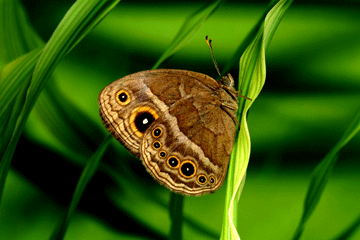Insect Development & Evolution Lab
(E&EB 249b/549b)

Insect Development & Evolution Lab
(E&EB 249b/549b)

When? Thursdays from 2:30pm-5pm
Where? OML Labs
Who is teaching it? Dr. Antónia Monteiro
Office Hours: Friday mornings (9 to 11 am) at OML room 326A
This lab course will focus on experiments with live butterflies, examining mechanisms of wing pattern development and of wing pattern evolution at the population level. Students will be exposed to classic as well as modern developmental and population biological techniques.
Nature and purpose of the course: This course will introduce students to a particular wing pattern in butterfly wings, the eyespots, and will train them in a range of experimental approaches to study the genetic and developmental basis of quantitative variation in eyespot morphology. The aim of this course is to introduce students to variation in developmental mechanisms and to both classic and modern experimental tools used to study these mechanisms.
Main topics to be covered: Experiments will include 1) classic perturbations of the signaling group of cells that differentiate eyespots during pupal wing development, 2) visualization of gene expression patterns on the wings by extracting developing wing discs and using antibodies to localize the presence of particular proteins in the eyespot centers, 3) rearing cohorts of larvae at different temperatures to study phenotypic plasticity of the eyespot patterns, and 4) producing a shift in the mean size of eyespots in a population by the application of artificial selection to that trait.
Principal readings: Students will follow a dedicated syllabus for the lab course.
Format: Students will be involved in insect rearing throughout the course, in measuring eyespots in adult butterflies, in operating pupal wings and dissecting larval wings, and in visualizing gene expression patterns using antibody stainings and a fluorescent microscope.
Course prerequisites: This lab course can be taken simultaneoulsy or subsequently to E&EB 248. Recommended preparatory courses include Principles of Molecular, Cellular and Developmental Biology (MCDB 120a), or Principles of Evolution, Ecology, and Behavior (E&EB 122b), or Genetics (MCDB 200a).
Syllabus
1st week: The students will visit the butterfly insectary and learn about a butterfly’s life cycle and about how phenotypic plasticity lines were set up in advance in preparation for this lab course. Larvae will have been reared at three different temperatures (17C, 23C, and 28C) in special incubators. These will be called the plasticity lines. They will also practice handling and measuring adult butterflies under a microscope with an ocular micrometer.
2nd week: The class will measure the diameter of a single eyespot, as well as wing size, on approximately 100 male and 100 virgin female butterflies and will select the most extreme individuals (the ones with the largest eyespot/wing size ratio and the smallest ratio) to mate with each other in two separate mating cages. These will be called the selection lines.
3rd week: Students will check on the selection lines: they will remove plants with eggs laid by the selected parents and place them in larval cages. Students will measure the size of the eyespots of butterflies from the plasticity lines.
4th week: Students will observe how to conduct operations on pupae of a known age that pupated at variable times before class. These operations will involve ablating the eyespot central signaling cells or transplanting them to a new location on the wing. If there are enough animals, students can also practice doing these operations.
5th week: Students will check on the selection lines and on the operated animals that will have since emerged. They will continue to perform focal ablations on a new set of animals that pupated at known times, shortly before class.
6th week: Students will check on their selection lines and will finish measuring the eyespot size of all the animals that were operated via a focal ablation. They will determine the effect of the operation on eyespot size by comparing eyespot diameters between right and left wings (only one of which was operated). They will correlate eyespot size with the age of the pupa at the time of the operation.
7th week: Students will work on analyzing the data from the plasticity and focal ablation experiments.
8th week: Students will present data to the rest of the class about their plasticity and focal ablation experiments. Two reports due.
9th week: Students will check on their selection lines. They will learn how to extract larval wings from fifth instar larvae and on how to fix them and prepare them for immunohistochemistry. They will leave the wings bathing in a primary antibody targeting the engrailed protein.
10th week: Students will finish the immunohistochemistry procedure. They will check on their selection lines.
11th week: Students will visualize the result of their immunohistochemistry experiments under a fluorescent microscope. They will start measuring the size of the eyespots of the offspring of the butterflies selected up and down.
12th week: Students will finish measuring the size of the eyespots of butterflies from the selection lines and will work on analyzing their data.
13th week: Students will present data to the rest of the class about the selection lines and immunohistochemistry experiments. Two reports due.
Grades for the course will be based on the following:
|
Undergraduates |
|
|
2 mid-term reports |
100 points |
|
2 final reports |
100 points |
|
Total |
200 points |